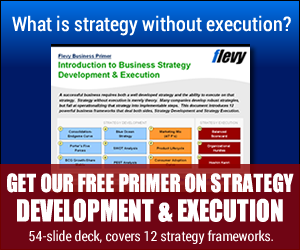Pattern recognition today is a popular topic largely because pattern recognition techniques have leveraged advanced technology, such as Machine Learning and Artificial Intelligence. However, there also is very much a human side to pattern recognition, and it is applicable to developing strategies and managing projects.
This post explores the value of pattern recognition, where it is used, for example, in venture capital, how it is embedded in best practices for strategy and project management, and how you can become better at it.
What Is Pattern Recognition?
 Pattern recognition is the identification of common elements and behavioral characteristics that tend to repeat themselves and make outcomes more predictable.
Pattern recognition is the identification of common elements and behavioral characteristics that tend to repeat themselves and make outcomes more predictable.
Pattern recognition applies broadly across fields; whether you are an artist, athlete, investor…or a strategist or project manager. Recognizing the patterns that naturally occur in situations that we encounter can make us much more effective at what we do.
I often like to look outside my immediate field to other fields of interest, where I can learn something that I can then transplant and apply back in my own field. In this post, we explore the use of pattern recognition in the Venture Capital (VC) field, and relate it back to the practice of pattern recognition in strategy and project management.
Bruce Dunlevie, a Venture Capitalist at Benchmark Capital, said,
“Pattern recognition is an essential skill in venture capital…while the elements of success in the venture business do not repeat themselves precisely, they often rhyme. In evaluating companies, the successful VC will often see something that reminds them of patterns they have seen before.”
Indeed, the idea that practice makes perfect, and the power of repetition and accumulation of knowledge across these experiences is valuable at a minimum for speed and efficiency, as time is money. In Venture Capital, this translates to being able to better recognize patterns which expose positive or negative attributes – and to invest accordingly.
What are some of these attributes?
- Founder’s experience on prior startups – VC’s highly value founder experience and prefer someone who has led several successful startups
- Uniqueness of technology – something that breaks through a barrier, is hard to emulate, adds value, and is needed
- Uniqueness of business model – a delivery system that simplifies a system or rearranges how it appears to the delight of the customer
- The pain intensity for the problem to be solved – the ‘intensity’ gives an indication of how badly customers might want it, and thus how quickly learning can happen and good results generated
- The team behind it – always a critical factor, VC’s want to see great people in each position
- Timing – Is the market ready for this at this time?
This is very simplistic, but it captures the idea that there is a structured process built around an understanding of patterns of success. Based upon experience with these attributes, a template-like checklist is used as part of a rigorous yet efficient process for identifying the most-likely-to-succeed startup investments.
Some Common Pattern Recognition Techniques
 Pattern recognition is a very complex topic – as mentioned, it can involve such things as Machine Learning and Artificial Intelligence. However, there is a much more practical level where working people can improve their performance through good pattern recognition.
Pattern recognition is a very complex topic – as mentioned, it can involve such things as Machine Learning and Artificial Intelligence. However, there is a much more practical level where working people can improve their performance through good pattern recognition.
One way to think about pattern recognition for people is to consider these three types:
- Statistical – This is where we rely on analytical observations made based on studying the data. We can look for cause and effect, correlations, and trends.
- Tactile – We can also ‘feel’ a pattern. For many individuals, gut feel is the manifestation of years of experience and is worth considering along with more analytical considerations. (Read “Blink: The Power of Thinking Without Thinking“, by Malcolm Gladwell!)
- Templates – The combined experience of many individuals can be embedded in templates to account for the patterns that are most likely to produce a successful outcome.
In Venture Capital, these pattern recognition techniques are used to develop a process to ensure all the important factors are covered, to enable an analyst to go through the process rapidly, and to rapidly give analysts the experience distinguishing alternatives to identify the best investments.
Let’s now turn to how pattern recognition techniques are utilized in both strategy and project management.
Pattern Recognition in Organizational Strategy
—————————————-
I recommend these strategy resources (paid link):
—————————————-
Strategic frameworks are all about pattern recognition of some sort. Think about this sampling of common frameworks covered in this blog so far:
- Consolidation Endgame Curve – built upon the observation that industries consolidate over the occurrence of four predictable phases of development
- Design Thinking – built upon the idea that there are rigorous techniques in dealing directly with prospective customers and monitoring their customer experience (CX), rather than relying on broad demographic and other data
- Innovation Management – derives from the idea that innovation is a process that takes discipline and effort, and that it can be learned and built into an organization’s culture
- Ecosystems – the observation that many network-based businesses today follow a pattern where there is an orchestrator and partner participants, both with good but different value creating opportunities
- First Mover Advantage – based on patterns that evolve for first movers and later movers, where there are common risks and opportunities at each stage of market development
- The S Curve – graphically demonstrates the natural occurrence of the pattern of a slow start, acceleration period, and a slowdown related to such things as cost, labor hours, and quality
- Balanced Scorecard – codifies a way to do more effective reporting (scoring) based on a pattern of success resulting not only from financial measures, but also measures related to customers, internal processes, and learning/development
- Evolution of strategy and project management – observes common patterns in the evolution of the practice of strategy and project management
Applying these types of patterns in practice – matching the right situations to the right patterns and understanding the nuances – is the true refined skill of experience.
How to Get Better at Recognizing Patterns as a Project Manager
The challenge is repetition. Unlike the analysis of a VC investment, which can take from a few hours to a few days, projects last anywhere from a couple of weeks to a couple of years or even more. In part that depends on your field and the types of projects you work on, but it also depends upon the type of position you have.
—————————————-
I recommend these PM templates (paid link):
—————————————-
So how can a project manager get experience on scores or even hundreds of projects and develop strong recognition of patterns of success?
Here are some ideas:
- If you work on long duration projects – You do not have an opportunity to gain experience across a multitude of projects on the job, because they simply stake too long. Take the time to study past and current projects in your organization or industry and look for patterns. Also study different types – even shorter – of projects.
- If you work on small to medium duration projects – You will probably accumulate a larger number of experiences that will help you see patterns. Try to reach out and either gain experience or study or talk with others about projects in other areas, of different types, and in different industries.
- You work in a PMO Type of Organization – Here you have the opportunity to get a broader view across many projects. The caution is to ensure you delve deep enough into the projects to get the full flavor and recognize the patterns emerging.
Here is a summary list of five ways you can circumvent the challenge of getting experience across many projects to build pattern recognition skill across projects.
- Read about successful as well as failed projects.
- Listen to podcasts to expand your base of experience.
- Practice your PM skills on home, side, and volunteer projects.
- Read PM, strategy, and related blogs to expand your experience.
- Share experiences with other project managers inside and outside your organization.
So, while practically you may not be able to build experience by working on hundreds of projects in a year, as a venture capitalist would review deals, there are other ways of getting that experience and expanding your frame of reference.
Recognizing Valuable Patterns In Your Projects
I hope this post has highlighted the value of recognizing patterns on your projects, how to expand your experience base beyond your own projects, and how to apply knowledge derived from patterns on your projects. In short, the best things you can do are to recognize what techniques have worked or not, and to network with other project managers.
Finally, a great way to leverage pattern recognition on projects is to use project management templates. Doing so effectively still requires experience, and your judgment will still be informed by what you have been exposed to, but a full range of knowledge and experience with pattern recognition on projects is embedded in the templates.


